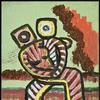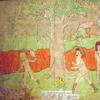MFA Boston Kicks Off Spring with 2 Powerful Exhibitions: 'Philip Guston: Now' and 'Turner's Modern World'
- February 01, 2022 12:19

This spring, the Museum of Fine Arts, Boston, brings focus to a pair of differing game-changer artists, J. M. W. Turner and Philip Guston, who responded to their own tumultuous times with innovative artistic visions.
One of Britain’s greatest artists, J. M. W. Turner (1775–1851) lived and worked at the peak of the industrial revolution, when steam replaced sail, machine power replaced manpower, and wars, political unrest and social reforms transformed society. At the Museum of Fine Arts, Boston, from March 27 to July 10, 2022, the exhibition Turner’s Modern World will explore how this artist, more than any of his contemporaries, embraced these changes and developed an innovative painting style to better capture this new world.

This landmark exhibition brings together more than 100 paintings, watercolors, drawings and sketchbooks by Turner, including Tate Britain’s Snow Storm: Hannibal and his Army Crossing the Alps (1812), The Burning of the Houses of Lords and Commons, October 16, 1834 (1835) from the Cleveland Museum of Art and the MFA’s own Slave Ship (1840). These vivid and dramatic compositions demonstrate Turner’s commitment to depicting the great events and developments of his time, from technological advances to causes such as abolition and political reform. Turner’s Modern World is organized by Tate Britain in association with the Kimbell Art Museum and the MFA.
Also coming to the MFA (May 1 to Sept. 11, 2022), Philip Guston: Now is a touring exhibition that caused controversy when the dates were initally rescheduled to four years out. One of America’s greatest modern painters, Philip Guston (1913–1980) defies easy categorization. His winding 50-year career, in which sensitive abstractions gave way to large, cartoonlike canvases populated by lumpy, sometimes tortured figures and mysterious personal symbols, has excited both admiration and controversy.
This major exhibition—organized by the MFA, the National Gallery of Art, Washington, the Museum of Fine Arts, Houston, and Tate Modern, London—is the first retrospective of Guston’s work in nearly 20 years. The selection of approximately 90 paintings and 30 drawings from public and private collections features well-known works as well as others that have rarely been seen. Highlights include paintings from the 1930s that have never been on public view; the largest reunion of paintings from Guston’s groundbreaking Marlborough Gallery show in 1970; a dazzling array of small panel paintings made from 1968 to 1972 as he developed his new vocabulary of hooded heads, books, bricks and shoes; and a powerful selection of large, often apocalyptic paintings of the later 1970s that form the artist’s last major artistic statement.











![Peter Paul Rubens (Flemish, 1577–1640), After Titian (Tiziano Vecelli) (Italian [Venetian], c. 1488–1576), Rape of Europa, 1628–29. Oil on canvas, 71 7/8 x 79 3/8 in. Peter Paul Rubens (Flemish, 1577–1640), After Titian (Tiziano Vecelli) (Italian [Venetian], c. 1488–1576), Rape of Europa, 1628–29. Oil on canvas, 71 7/8 x 79 3/8 in.](/images/c/e2/2e/Jan20_Rape_of_Europa100x100_c.jpg)









